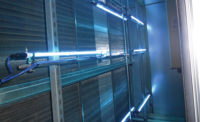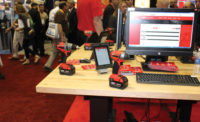LAS VEGAS — The immediate benefits of UV are becoming more pronounced as UV light has the ability to eliminate accumulated organic materials and biofilm growth in air handlers.
According to the U.S. Environmental Protection Agency (EPA), the air inside the average home is up to five times more polluted than its outdoor counterpart, making the job of UV/air-purification products all the more important.
COST AND SAFETY
Manufacturers showed off their recent efforts to ease the installation of UV products, find safe and simple solutions to air-purification problems in both the commercial and residential markets, and keep an eye on standards that may be coming in the future at the AHR Expo.
“Building managers and architects are increasingly looking for energy-efficient technologies that will reduce their buildings’ energy costs,” said Dan Jones, president, UV Resources.
According to Jones, increasing electricity costs have led building managers to look for ways to reduce their energy demand.
“The use of UV-C fixtures has proven to be a very effective way of delivering those reductions, saving a significant amount of energy use on an air handler,” he said. “Additionally, UV-C’s ability to maintain coil cleanliness offers a bonus savings in man power by removing the need to mechanically clean coils annually.”
UV Resources is releasing a safety and installation upgrade to its RLM Xtreme fixtureless ultraviolet (UV-C) lamp system. The pre-wired 24-V Contact Controller can regulate up to six safety interlock switches to protect operators by de-energizing the UV-C system when an access door/panel is opened. Multiple access doors can be interlocked with one Contact Controller, which also helps speed up UV system installation while complying with new UL 1995 safety standards that go into effect in November 2019. The standards require, among other things, points of access to UV sources to be equipped with an interlocking mechanism to de-energize the source.
Robert Scheir, president and CEO, Steril-Aire, said it’s important to focus on what matters most.
“Too much in our industry has been based on buzzwords rather than the science behind the solutions,” he said. “This has allowed some players to make claims that go unchallenged by end users because of the complexity of what is necessary.”
Steril-Aire has released its Rapid Install Kit (RIK). The kit is designed to bring solutions into a systems’ approach toward delivery of UV-C intensity in an easier installation.
“For years, design of UV-C was about the geography of how many bulbs covered how much area,” said Scheir. “Unfortunately, different manufacturers’ UV-C delivery systems varied in their intensity or killing power so it was not a scientific way to design. Due to efforts spearheaded by Steril-Aire, customers are now looking at intensity striking the coil face to determine efficacy of the solution.”
Ultravation’s one-piece UV lamp, the UVC-Advantage™, has a built-in power supply to streamline UV light for HVAC disinfection. It offers a photocatalytic oxidation (PCO) purification upgrade, and a complete unit replacement can be done at either the end of a lamp’s life or to repair the unit.
Fresh-Aire UV, a division of Triatomic Environmental Inc., introduced the Mini UV CE, an ultraviolet germicidal irradiation (UVGI) light system that’s Certified Europe (CE) compliant and features an advanced power supply with a lifetime warranty.
The Mini UV CE’s advanced active power supply with a digital filtering process accommodates every mini-split heat pump brand, including all inverter models rated for the Code of Federal Regulation’s (CFR) 14 SEER or greater.
ATTACKING ODORS
UV-C and air-purification are crucial technologies when it comes to eliminating odors, molds, bacterias, and volatile organic compounds (VOCs).
Per Fresh-Aire UV, the Mini UV CE inhibits mold and other biological growth on blower and evaporator coil surfaces and sterilizes germs, viruses, allergens, and other pathogens that can flourish in HVAC systems from condensation moisture.
RGF Environmental Group Inc. introduced its UPCO QR™ PCO in-duct air purifying system.
Per the company, the combination of technologies incorporated into the UPCO QR work to create a low-pressure-loss, pure-carbon-infused bed. Combining titanium dioxide, silver, copper, and zinc metal into this proprietary dual-catalyst bed traps and then reduces common indoor air pollutants. VOCs, bacteria, viruses, mold spores, and odors are effectively diminished as air cycles repeatedly through the HVAC system, which results in improved IAQ for both residential and commercial applications.
Removing odor was a topic Fresh-Aire UV president, Chris Willette, highlighted as being important to the future of the industry.
“UV light itself cleans the coil and can clean some of the bugs in the air, but it’s not always the best when it comes to getting rid of odors. We use carbon technology, absorb everything, and then use the light as a catalyst to generate carbon, which is vitally important.”
Dust Free LP’s PuriFi Monitor tracks the status of a homeowner’s in-duct air-purification devices to ensure the air delivered to the home has been purified. It alerts homeowners if the system’s UV lights go offline or need to be replaced. In addition, it will connect to a TZOA in-duct particulate sensor to continuously monitor the amount of harmful particulate in the airstream, indicating whether the home’s filtration system is active and effective.
Plasma Air Intl.’s Plasma BAR Bipolar Ion Generator is a needlepoint-type bipolar ionizer arranged in a long, narrow bar design. According to the company, the unit is installed at the air-entering side of the cooling coil of an air-handling unit (AHU) or rooftop unit (RTU). The installer mounts the Plasma BAR using the provided brackets ensuring that the ionization needles are pointed down to avoid debris accumulating on the needles. It reduces harmful pollutants and odors by introducing positive and negative ions into the system airflow, which is then delivered to the space.
Publication date: 2/27/2017
Want more HVAC industry news and information? Join The NEWS on Facebook, Twitter, and LinkedIn today!









